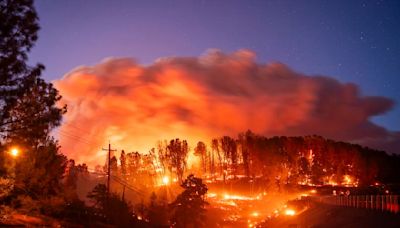Search results
Sep 10, 2024 · Wildland Fires Scorch Idaho Wilderness. Burning for weeks, the Wapiti and Middle Fork Complex fires have charred tens of thousands of acres. Published Sep 3, 2024. Image of the Day Atmosphere Land Fires
Wildfire smoke is a mixture of air pollutants of which particulate matter (PM) is the principal public health threat. PM 2.5 from wildfire smoke is associated with premature deaths in the general population, and can cause and exacerbate diseases of the lungs, heart, brain/nervous system, skin, gut, kidney, eyes, nose and liver.
Jan 30, 2024 · Fires, explosions and volcanic eruptions can damage and contaminate food and water due to heat, smoke, fumes and chemicals. These flyers include tips to reduce food safety risks during a fire incident for households, food suppliers, vendors, food industry inspectors and workers. for food suppliers and vendors (2.940Mb).
Apr 14, 2022 · Fires involving oil can last for several days and be difficult to extinguish. Burning oil produces a wide range of pollutants, such as soot (mostly carbon) and gases (mainly carbon dioxide, carbon monoxide, sulfur dioxide, nitrogen oxides, volatile organic compounds [e.g., benzene], polycyclic aromatic hydrocarbons, hydrogen sulfide, and acidic gases [e.g., sulfuric acid]).
Carbon monoxide (CO) is a colourless, odourless gas produced by the incomplete combustion of carbonaceous fuels such as wood, petrol, coal, natural gas and kerosene in simple stoves, open fires, wick lamps, furnaces, fireplaces. The predominant source of carbon monoxide (CO) in ambient air is from motor vehicles.
Oct 13, 2023 · Enclose fires and limit the height of open flames in domestic environments. Promote safer cookstoves and less hazardous fuels and educate regarding loose clothing. Apply safety regulations to housing designs and materials and encourage home inspections.
Sep 22, 2021 · In contrast, a rural area near to a forest may have particulate matter consisting of soil, smoke from cookstoves and forest fires. Air pollutants measured include PM 2.5 and PM 10 (particles with an aerodynamic diameter of equal or less than 2.5, also called fine, and 10 micrometre respectively), ozone (O 3 ), nitrogen dioxide (NO2), carbon monoxide (CO) and sulfur dioxide (SO2).
Dec 15, 2023 · Worldwide, around 2.3 billion people still cook using solid fuels (such as wood, crop waste, charcoal, coal and dung) and kerosene in open fires and inefficient stoves (1). Most of these people are poor and live in low- and middle-income countries. There is a large discrepancy in access to cleaner cooking alternatives between urban and rural ...
Jul 29, 2024 · Household combustion devices, motor vehicles, industrial facilities and forest fires are common sources of air pollution. Pollutants of major public health concern include particulate matter, carbon monoxide, ozone, nitrogen dioxide and sulfur dioxide. Outdoor and indoor air pollution cause respiratory and other diseases and are important sources of morbidity and mortality.
Nov 30, 2023 · The term “chemical incident” might refer to anthropogenic or technological events, including: an outbreak of disease that is associated with a chemical exposure. Chemical incidents arising from natural sources include volcanos, earthquakes and forest fires. An estimated 65 000 people died due to technological events between 2009-2018.





